

A history of World War One in 10 deadly weapons. Weapons of World War I. First World War. World War One - Weapons. During World War One a variety of weapons were used.
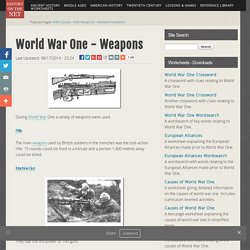
Rifle The main weapon used by British soldiers in the trenches was the bolt-action rifle. 15 rounds could be fired in a minute and a person 1,400 metres away could be killed. Machine Gun Machine guns needed 4-6 men to work them and had to be on a flat surface. They had the fire-power of 100 guns. Large field guns had a long range and could deliver devastating blows to the enemy but needed up to 12 men to work them. Gas The German army were the first to use chlorine gas at the battle of Ypres in 1915. Strategic bombing during World War I. Strategic bombing during World War I (29 July 1914 – 11 November 1918) was principally carried out by the United Kingdom and France for the Entente Powers and Germany for the Central Powers.
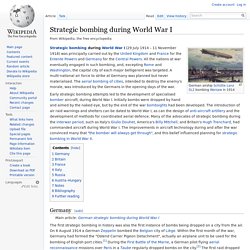
All the nations at war eventually engaged in such bombing, and, excepting Rome and Washington, the capital city of each major belligerent was targeted. A multi-national air force to strike at Germany was planned but never materialised. The aerial bombing of cities, intended to destroy the enemy's morale, was introduced by the Germans in the opening days of the war.
Germany[edit] The first extended campaigns of strategic bombing were carried out against England by the German Empire's fleet of airships, which were then the only aircraft capable of such sustained activities so far from their bases. In May 1917 the Germans began using heavy bombers against England using Gotha G.IV and later supplementing these with Riesenflugzeuge ("giant aircraft"). Britain[edit] WW100 New Zealand. Researching New Zealand soldiers in the First World War - Researching New Zealand soldiers. 100,000 New Zealand men signed up to fight for King and Country in the First World War.
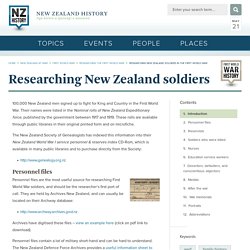
Their names were listed in the Nominal rolls of New Zealand Expeditionary force, published by the government between 1917 and 1919. These rolls are available through public libraries in their original printed form and on microfiche. Milsurps Knowledge Library - 1915 M10 Ross MkIII* Sniper Rifle. 1915 M10 Ross MkIII* Sniper Rifle Serial #223 (Mfg by The Ross Rifle Company, Quebec) c/w Model 1913 Warner & Swasey Telescopic Musket Sights Serial # 18 Weight 2 lbs 3.3 oz. .... 5.2x power scope with 1 1/2" eye relief c/w Leather Carrying Case (Mfg in 1915 by M.J.
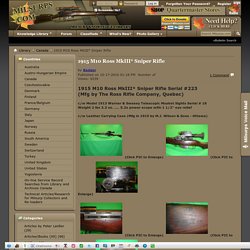
Wilson & Sons - Ottawa) (Click PIC to Enlarge) Weapons of War: Trench Mortars. As with the grenade the mortar was yet another old weapon which found a new lease of life during World War One.
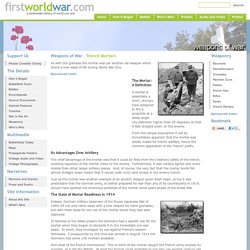
The Mortar: A Definition A mortar is essentially a short, stumpy tube designed to fire a projectile at a steep angle (by definition higher than 45 degrees) so that it falls straight down on the enemy. From this simple description it will be immediately apparent that the mortar was ideally suited for trench warfare, hence the common application of the 'trench' prefix.
Its Advantages Over Artillery. Weapons of World War I. World War I weapons consisted of various types of weapons standardised and improved over the preceding period together with some newly developed types using innovative technology and a number of improvised weapons used in trench warfare.
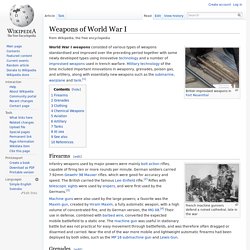
Military technology of the time included important innovations in weaponry, grenades, poison gas, and artillery, along with essentially new weapons such as the submarine, warplane and tank.[1] Firearms[edit] French machine gunners defend a ruined cathedral, late in the war Infantry weapons used by major powers were mainly bolt action rifles, capable of firing ten or more rounds per minute.
German soldiers carried 7.92mm Gewehr 98 Mauser rifles. which were good for accuracy and speed. Grenades[edit] Grenades proved to be effective weapons in the trenches but when the forces arrived their numbers and capabilities were inadequate. German discus grenades with multiple impact fuses proved inadequate. Discover World War One - Archives New Zealand. Te Rua Mahara o te Kāwanatanga.
NZDF Personnel Files Archives New Zealand holds the New Zealand Defence Force (NZDF) Personnel Files for all known New Zealanders who served in the First World War.
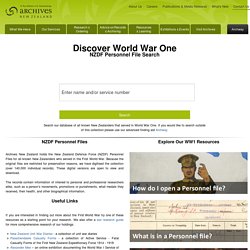
Because the original files are restricted for preservation reasons, we have digitised the collection (over 140,000 individual records). These digital versions are open to view and download. The records contain information of interest to personal and professional researchers alike, such as a person’s movements, promotions or punishments, what medals they received, their health, and other biographical information. Useful Links. Encyclopedia Britannica. Machine gun. Top: IMI Negev (light machine gun).
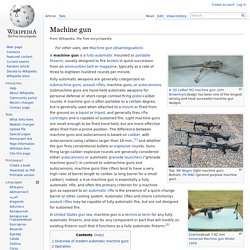
Bottom: FN MAG (general purpose machine gun). Fully automatic weapons are generally categorized as submachine guns, assault rifles, machine guns, or autocannons. Submachine guns are hand-held automatic weapons for personal defense or short-range combat firing pistol-caliber rounds. A machine gun is often portable to a certain degree, but is generally used when attached to a mount or fired from the ground on a bipod or tripod, and generally fires rifle cartridges and is capable of sustained fire. Light machine guns are small enough to be fired hand-held, but are more effective when fired from a prone position. In United States gun law, machine gun is a technical term for any fully automatic firearm, and also for any component or part that will modify an existing firearm such that it functions as a fully automatic firearm.[2] Overview of modern automatic machine guns[edit] According to U.S.
Light machine guns usually have simple iron sights. How Machine Guns Work - HowStuffWorks. Historians count the machine gun among the most important technologies of the past 100 years.
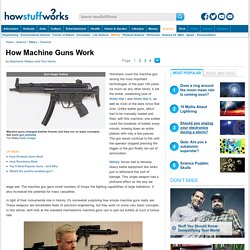
As much as any other factor, it set the brutal, unrelenting tone of World War I and World War II, as well as most of the wars since that time. Unlike earlier guns, which had to be manually loaded and fired, with this machine, one soldier could fire hundreds of bullets every minute, mowing down an entire platoon with only a few passes. The gun would continue to fire until the operator stopped pressing the trigger or the gun finally ran out of ammunition. Military forces had to develop heavy battle equipment like tanks just to withstand this sort of barrage. This single weapon had a profound effect on the way we wage war. In light of their monumental role in history, it's somewhat surprising how simple machine guns really are. Wwiweapons.pdf.